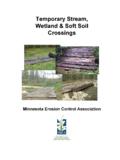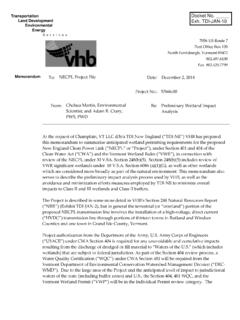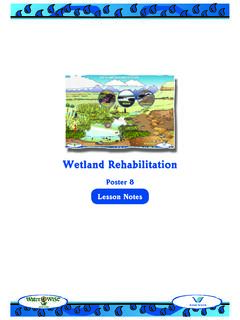Transcription of CREATING NEW WETLANDS: KEY PRINCIPLES AND ... - …
1 CREATING NEW WETLANDS: KEY PRINCIPLES AND A PROJECT MODEL Report prepared by ELP on behalf of the Broads Authority and Natural England August 2008 2 CREATING NEW WETLANDS: KEY PRINCIPLES AND A PROJECT MODEL Report prepared by ELP on behalf of the Broads Authority and Natural England August 2008 ELP Team: Mike Harding Brenda Williamson Client Team: Sandie Tolhurst, Project Manager Broads Authority Clive Doarks, Project Manager, Natural England. Ecology, Land Broads Natural & People Authority England 3 Tokio Road 18 Colgate 122a Thorpe Road Ipswich Norwich Norwich Suffolk Norfolk Norfolk IP4 5BE NR3 1BQ NR1 1RN 01473 723848 01603 610734 01603 631033 3 CONTENTS SUMMARY 4 1.
2 INTRODUCTION AND AIMS 6 2. wetland CREATION CASE STUDIES 7 Gathering The Case Studies 7 Conclusions 7 3. THE VALUE OF THE ECOSYSTEMS APPROACH AND SOCIO-ECONOMIC IMPACT ASSESSMENTS TO wetland CREATION PROJECTS 9 A Critical Contribution To Large wetland Projects 9 The Ecosystem Approach and Ecosystem Services 9 Socio-Economic Valuations and Impact Assessments 11 Conclusion: The Flaws and Benefits of Adopting the Two Approaches 14 4. A MODEL FOR DEVELOPING A wetland (RE-)CREATION PROJECT 16 5.
3 REFERENCES 21 Appendix 1: Case Studies of wetland Projects 22 Appendix 2: Case Studies of Socio-Economic Impact Assessments 42 Appendix 3: Twelve Broad PRINCIPLES for Adopting the Ecosystems Approach 46 4 SUMMARY This report reviews real wetland (re-)creation schemes and two theoretical approaches to environmental projects in order to identify best practice and common pitfalls. The results of this review are used to produce a model of wetland (re-)creation which can be used as a template to plan new projects. The model aims to maximise the benefits from new projects and minimise risk of failure.
4 The review of recent projects generates thirteen key conclusions. They may be summarised as: 1. A broadly-based and easily understood Vision for the project is important. 2. Acquiring the land is a key step which is highly unpredictable. 3. Obtaining the necessary permissions from regulators is a major milestone, requiring detailed studies and a good understanding of the requirements of many functions within the same agency. 4. Building support among the family of stakeholders is essential. Support for wildlife projects cannot be guaranteed, regardless of the size and resources of the organisation.
5 5. Building support requires time and resources, and cannot be short-cut. It is always worth the investment. 6. High level political support is vital for larger projects and may need engagement by all levels of the hierarchy of the partnership organisations. 7. Partnership works better than single organisation projects, as they bring a range of expertise, help develop stakeholder support and are favoured by funders. There are several disadvantages, however. 8. Detailed technical work may be needed to derive a sound restoration plan.
6 Investment made at this stage is highly cost-effective and the work is usually required by regulators. 9. A considerable degree of tenacity is required to see projects through, combined with a good understanding of technical issues, partnership working and the planning and institutional framework. The project manager is crucial in bringing these qualities to a project. 10. Skimping on the initial capital investment, by under-specifying works or using cheap materials, increases revenue costs in the long run. 11. Site set-up should include allowing machinery access and sustainable grazing to maximise long term management efficiency.
7 12. Good contractors, especially for the groundworks, are vital and the cheapest quote may not always be the most cost-effective. 13. Linking wildlife sites together is a key strategy for a project s success, both in terms of biodiversity benefits and in building support The Ecosystem Services Approach is explained and the benefits that it offers to wetland projects are described. The approach is particularly beneficial for projects that have multiple objectives. Adopting this approach is important in building support among stakeholders, as the wider benefits become apparent to those who are not wholehearted supporters of wildlife projects.
8 Similarly, the value of undertaking socio-economic valuations and Impact Assessments is described. A wide variety of models are available to provide evaluations of the social and financial benefits of a project, and to compare environmental projects to competing land uses. 5 More often than not, such analyses are strongly supportive of biodiversity projects and are very useful advocacy documents. Case examples are used to describe the benefits of both approaches. The complexity of the disciplines involved, and the fact that they are outside of the normal experience of wildlife planners, are significant barriers to their take-up by the conservation movement.
9 Drawing on the above material, a model is developed which summarises best practice. The model is a step-wise flow chart guiding a wildlife planner through the key stages and is supported by text which fleshes out some of the key considerations at each stage. The Case Studies for wetland projects and the applications of Ecosystems Services Approach and Socio-Economic Analyses are presented in appendices. They provide key facts and contacts and sources of further information. 61. INTRODUCTION AND AIMS The aim of this project is to review real wetland (re-)creation schemes and two theoretical approaches to environmental projects in order to identify best practice and common pitfalls.
10 The results of this review are to feed into development of a model of wetland (re-)creation which can be used as a template to plan new projects. The model provides guidance for conservation planners, to maximise the benefits from the project and minimise risk of failure. The project was conceived and jointly funded by the Broads Authority and Natural England. It arose out of separate initiatives being carried forward by each of the organisations, where it was recognised a joint approach would yield benefits to both. The Authorities wished to move forward on the integrated delivery at a whole river valley scale, and through this, promote or directly undertake wetland restoration projects on a large scale, perhaps whole catchments.





